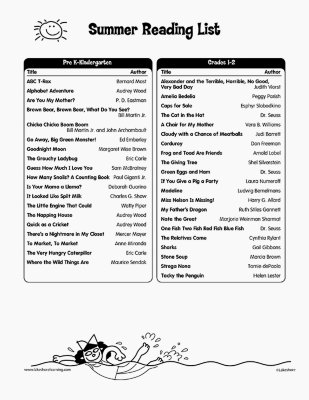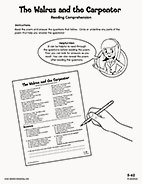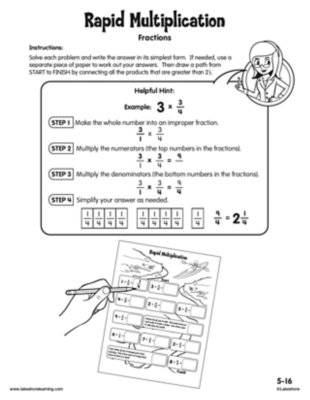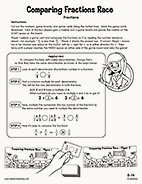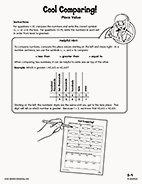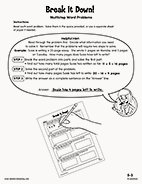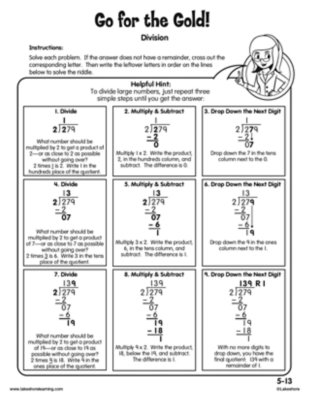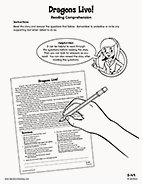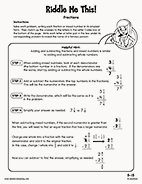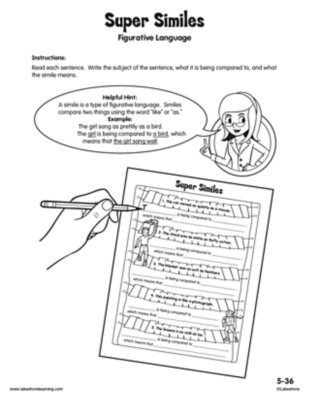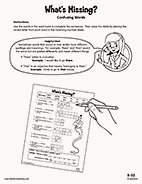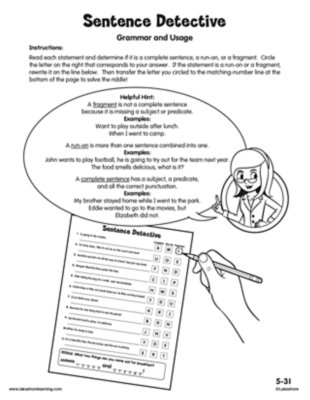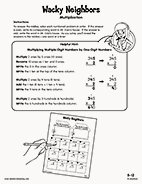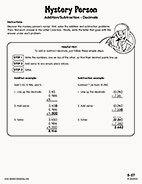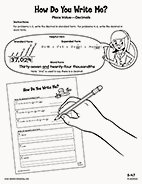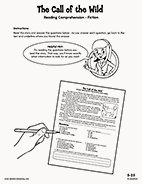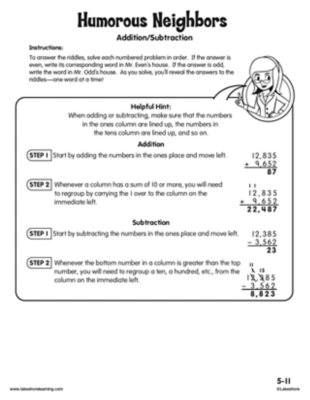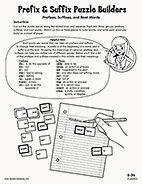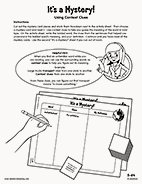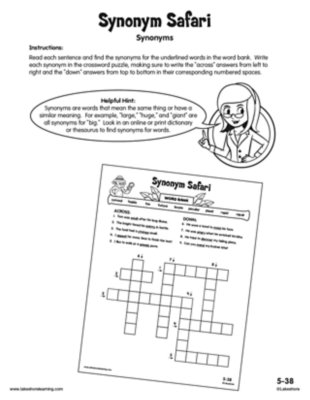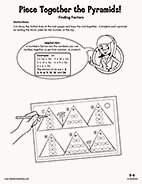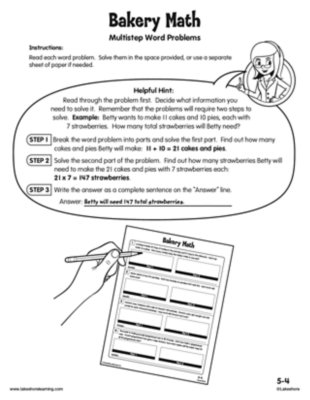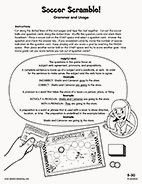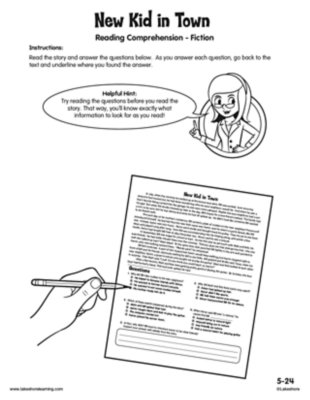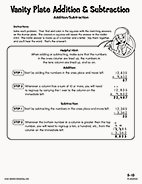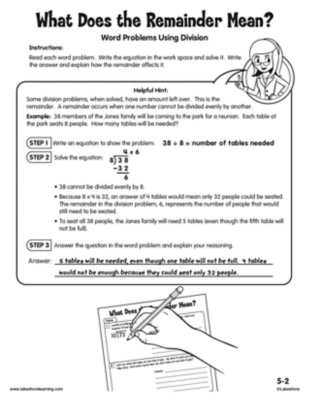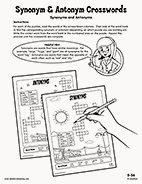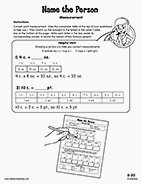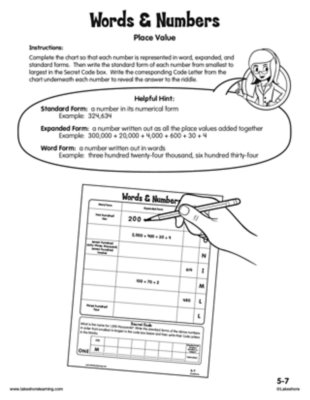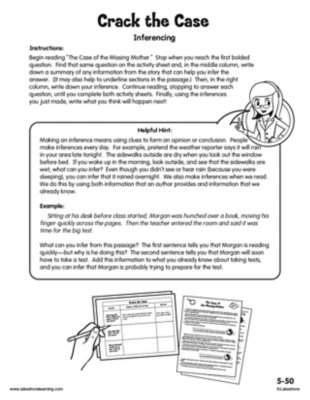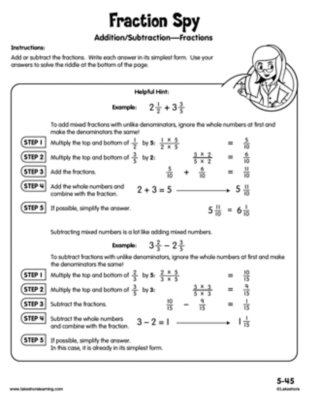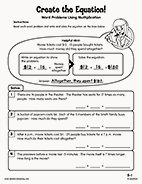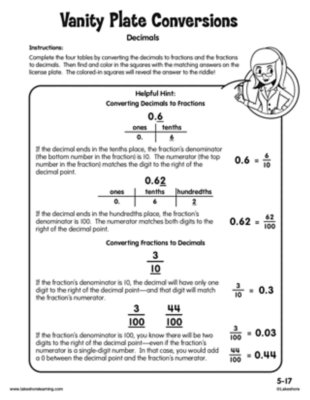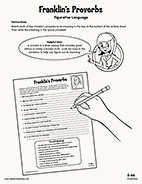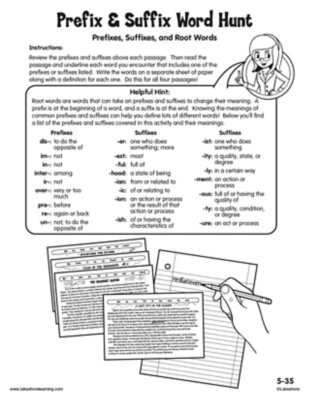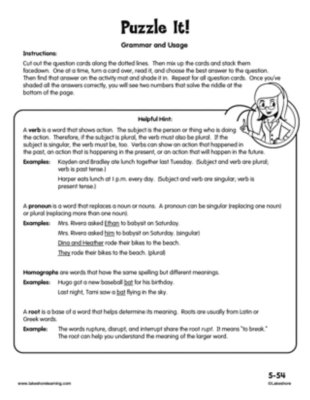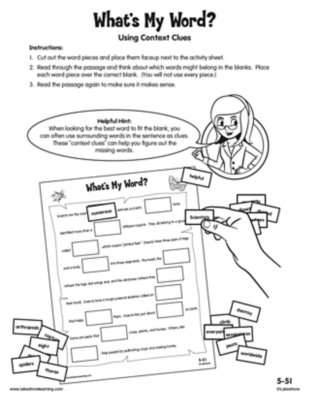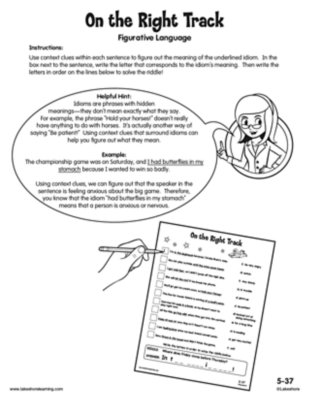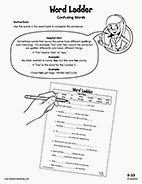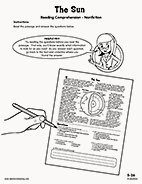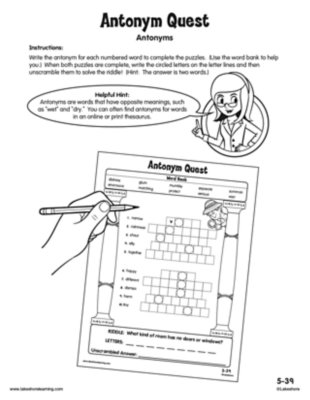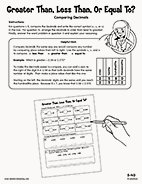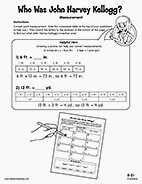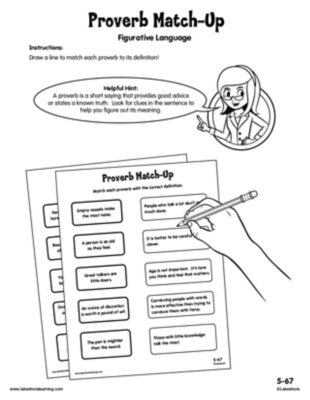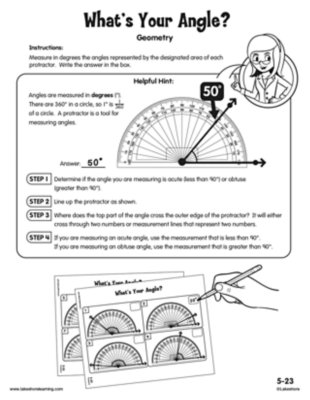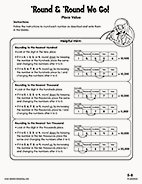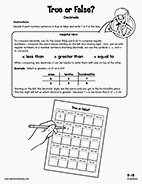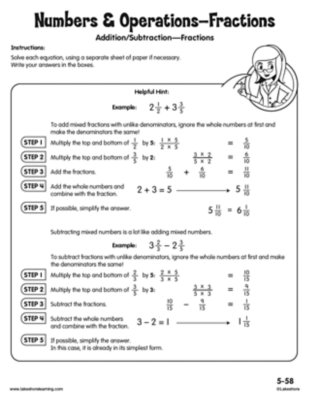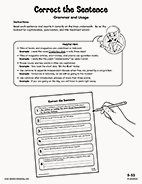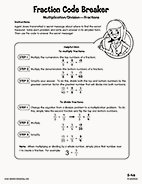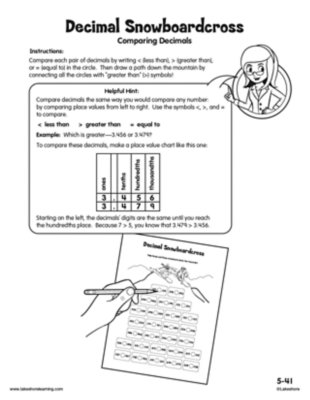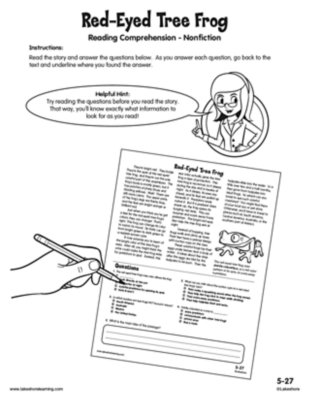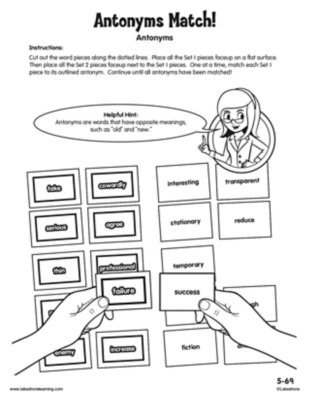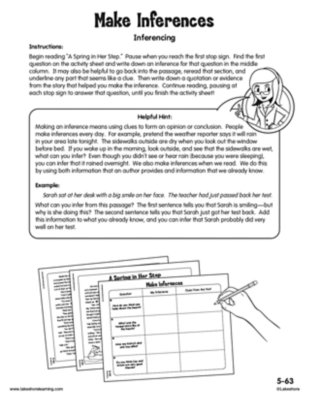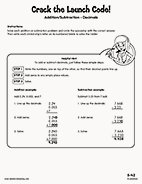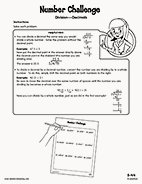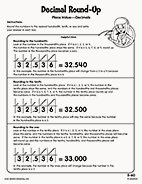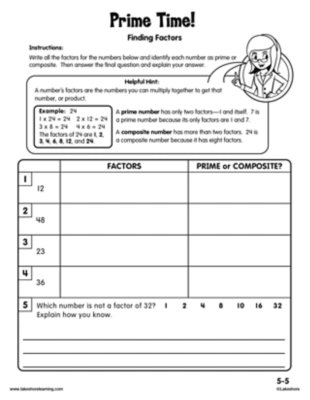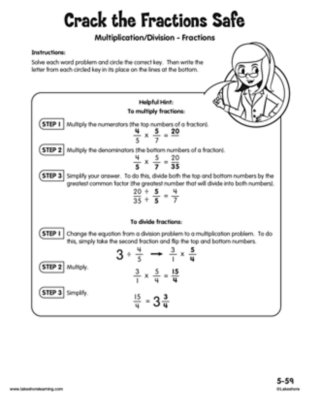Narrow by Grade
- Infant (0)
- Toddler (1)
- Preschool (1)
- Pre-K (3)
- Kindergarten (58)
- 1st (67)
- 2nd (90)
- 3rd (76)
- 4th (65)
- 5th (61)
- 6th & Up (1)
Grade 5th
Narrow by Age
- 0-18m (0)
- 18-36m (0)
- 3 yrs. (0)
- 4 yrs. (1)
- 5 yrs. (1)
- 6 yrs. (1)
- 7 yrs. (1)
- 8 yrs. (1)
- 9 yrs. (1)
- 10 yrs. (61)
- 11 yrs. & Up (1)
Age
0 results for "sand/" , here are results for "and"
During fifth grade, your child will learn to read and analyze level-appropriate stories, dramas, poems and nonfiction texts—summarizing key events and details, analyzing characters and identifying elements such as the main idea and author’s purpose.
View worksheetWhen entering fifth grade, your child should be able to compare fractions, add and subtract fractions with the same denominator and multiply a fraction by a whole number.
View worksheetWhen entering fifth grade, your child should be able to compare fractions, add and subtract fractions with the same denominator and multiply a fraction by a whole number.
View worksheetWhen entering fifth grade, your child should be able to compare and round multidigit numbers. Your child should also be able to read and write multidigit numbers in number, word and expanded form. For example, 765; seven hundred sixty-five; 700 + 60 + 5.
View worksheetWhen entering fifth grade, your child should be able to solve multistep word problems using addition, subtraction, multiplication and division, including problems with remainders.
View worksheetWhen entering fifth grade, your child should be able to multiply a number with up to four digits by a one-digit number and a two-digit number by another two-digit number. Your child should also be able to divide numbers with up to four digits by a one-digit number, including problems with remainders.
View worksheetDuring fifth grade, your child will learn to read and analyze level-appropriate stories, dramas, poems and nonfiction texts—summarizing key events and details, analyzing characters and identifying elements such as the main idea and author’s purpose.
View worksheetWhen entering fifth grade, your child should be able to compare fractions, add and subtract fractions with the same denominator and multiply a fraction by a whole number.
View worksheetWhen entering fifth grade, your child should be able to figure out the meaning of figurative language, including similes, metaphors and idioms.
View worksheetWhen entering fifth grade, your child should be able to correctly use frequently confused words, such as “to” and “two” or “there” and “their.”
View worksheetWhen entering fifth grade, your child should know how to correctly use words in sentences and should know many rules of English grammar and usage, including rules about relative pronouns (which, that), relative adverbs (where, when, why), the correct order of adjectives and more. Your child should also know how to use correct punctuation and capitalization when forming sentences and paragraphs.
View worksheetWhen entering fifth grade, your child should be able to multiply a number with up to four digits by a one-digit number and a two-digit number by another two-digit number. Your child should also be able to divide numbers with up to four digits by a one-digit number, including problems with remainders.
View worksheetDuring fifth grade, your child will learn to add and subtract decimals to the hundredths place. For example, 2.32 + 3.41 = 5.73.
View worksheetDuring fifth grade, your child will learn to read and write decimals in standard form, word form and expanded form to the thousandths place and round decimals to any place.
View worksheetWhen entering fifth grade, your child should be able to read, analyze and understand level-appropriate stories, dramas and poems—exploring key events and details, analyzing characters, examining point of view and making inferences.
View worksheetDuring fifth grade, your child will learn to multiply and divide decimals to the hundredths place. For example, 212 x 0.45 = 95.40.
View worksheetWhen entering fifth grade, your child should be able to easily add and subtract multidigit whole numbers.
View worksheetWhen entering fifth grade, your child should be able to use common, grade-appropriate Greek and Latin prefixes, suffixes and roots to figure out the meaning of a word. For example, “telegraph,” “photograph” and “autograph” all contain the Greek root “graph,” which refers to something that is written or drawn.
View worksheetDuring fifth grade, your child will learn to figure out the meaning of an unfamiliar word or phrase by using clues in the text, such as cause/effect relationships and comparisons. For example, in the following sentence, you can determine that the word “chastened” means “punished” by looking at the cause and effect: “When Judy found out that her son had cheated, she chastened him by taking away his video games.”
View worksheetWhen entering fifth grade, your child should be able to understand words by relating them to their opposites (antonyms) and to words with similar but not identical meanings (synonyms).
View worksheetWhen entering fifth grade, your child should be able to identify whether a number is prime or composite and find all the factor pairs for a whole number between 1 and 100. Factors are the numbers that can be multiplied together to reach another number. For example, the factor pairs for 6 are 1 and 6 (because 1 x 6 = 6) and 2 and 3 (because 2 x 3 = 6).
View worksheetWhen entering fifth grade, your child should be able to solve multistep word problems using addition, subtraction, multiplication and division, including problems with remainders.
View worksheetWhen entering fifth grade, your child should know how to correctly use words in sentences and should know many rules of English grammar and usage, including rules about relative pronouns (which, that), relative adverbs (where, when, why), the correct order of adjectives and more. Your child should also know how to use correct punctuation and capitalization when forming sentences and paragraphs.
View worksheetWhen entering fifth grade, your child should be able to read, analyze and understand level-appropriate stories, dramas and poems—exploring key events and details, analyzing characters, examining point of view and making inferences.
View worksheetWhen entering fifth grade, your child should be able to easily add and subtract multidigit whole numbers.
View worksheetWhen entering fifth grade, your child should be able to multiply and divide to solve word problems and be able to solve multistep word problems that involve multiplication and division.
View worksheetDuring fifth grade, your child will learn to use the relationship between synonyms (words with similar meanings) and antonyms (opposites) to better understand each of the words.
View worksheetWhen entering fifth grade, your child should be able to solve problems involving measurement and conversion of measurement.
View worksheetWhen entering fifth grade, your child should be able to compare and round multidigit numbers. Your child should also be able to read and write multidigit numbers in number, word and expanded form. For example, 765; seven hundred sixty-five; 700 + 60 + 5.
View worksheetWhen entering fifth grade, your child should be able to identify lines and angles, measure angles, understand symmetry and classify shapes based on their lines and angles. For example, your child should be able to classify right triangles by seeing that they have a 90-degree angle.
View worksheetDuring fifth grade, your child will learn to make inferences when reading fiction and nonfiction text passages, citing places in the text that led your child to draw certain conclusions.
View worksheetDuring fifth grade, your child will learn to add and subtract fractions with different denominators. For example, 1/3 + 1/4 = 4/12 + 3/12 = 7/12.
View worksheetWhen entering fifth grade, your child should be able to multiply and divide to solve word problems and be able to solve multistep word problems that involve multiplication and division.
View worksheetWhen entering fifth grade, your child should be able to compare decimals to the hundredths place, such as 0.45 and 0.07. Your child should also be able to write fractions with denominators of 10 or 100 as decimals, such as writing 3/10 as 0.3 and writing 34/100 as 0.34.
View worksheetDuring fifth grade, your child will learn to interpret examples of figurative language, including similes and metaphors, based on the context in which they are used. Your child will also learn to recognize and explain the meaning of common idioms and familiar sayings and expressions, such as, “A bird in the hand is worth two in the bush.”
View worksheetWhen entering fifth grade, your child should be able to use common, grade-appropriate Greek and Latin prefixes, suffixes and roots to figure out the meaning of a word. For example, “telegraph,” “photograph” and “autograph” all contain the Greek root “graph,” which refers to something that is written or drawn.
View worksheetDuring fifth grade, your child will learn many new rules of English grammar and usage, including how to correctly use verb tenses, conjunctions and prepositions in sentences. Your child will also learn new rules about the correct use of punctuation and capitalization when forming sentences and paragraphs.
View worksheetDuring fifth grade, your child will learn to figure out the meaning of an unfamiliar word or phrase by using clues in the text, such as cause/effect relationships and comparisons. For example, in the following sentence, you can determine that the word “chastened” means “punished” by looking at the cause and effect: “When Judy found out that her son had cheated, she chastened him by taking away his video games.”
View worksheetWhen entering fifth grade, your child should be able to figure out the meaning of figurative language, including similes, metaphors and idioms.
View worksheetWhen entering fifth grade, your child should be able to correctly use frequently confused words, such as “to” and “two” or “there” and “their.”
View worksheetWhen entering fifth grade, your child should be able to read, analyze and understand level-appropriate nonfiction reading passages, finding the main idea and important details, comprehending key words and phrases, comparing different accounts of the same event or topic and making inferences.
View worksheetWhen entering fifth grade, your child should be able to understand words by relating them to their opposites (antonyms) and to words with similar but not identical meanings (synonyms).
View worksheetDuring fifth grade, your child will learn to compare decimals to the thousandths place using the greater than (>), less than (<) and equal to (=) symbols, such as 0.392 > 0.329.
View worksheetWhen entering fifth grade, your child should be able to solve problems involving measurement and conversion of measurement.
View worksheetDuring fifth grade, your child will learn to interpret examples of figurative language, including similes and metaphors, based on the context in which they are used. Your child will also learn to recognize and explain the meaning of common idioms and familiar sayings and expressions, such as, “A bird in the hand is worth two in the bush.”
View worksheetWhen entering fifth grade, your child should be able to identify lines and angles, measure angles, understand symmetry and classify shapes based on their lines and angles. For example, your child should be able to classify right triangles by seeing that they have a 90-degree angle.
View worksheetWhen entering fifth grade, your child should be able to compare and round multidigit numbers. Your child should also be able to read and write multidigit numbers in number, word and expanded form. For example, 765; seven hundred sixty-five; 700 + 60 + 5.
View worksheetWhen entering fifth grade, your child should be able to compare decimals to the hundredths place, such as 0.45 and 0.07. Your child should also be able to write fractions with denominators of 10 or 100 as decimals, such as writing 3/10 as 0.3 and writing 34/100 as 0.34.
View worksheetDuring fifth grade, your child will learn to add and subtract fractions with different denominators. For example, 1/3 + 1/4 = 4/12 + 3/12 = 7/12.
View worksheetDuring fifth grade, your child will learn many new rules of English grammar and usage, including how to correctly use verb tenses, conjunctions and prepositions in sentences. Your child will also learn new rules about the correct use of punctuation and capitalization when forming sentences and paragraphs.
View worksheetDuring fifth grade, your child will learn to multiply fractions by whole numbers and by other fractions (2/3 x 4 = 8/3 or 2/3 x 4/5 = 8/15). Your child will also learn to divide fractions by whole numbers and whole numbers by fractions (1/3 ÷ 4 = 1/12 or 4 ÷ 1/2 = 8).
View worksheetDuring fifth grade, your child will learn to compare decimals to the thousandths place using the greater than (>), less than (<) and equal to (=) symbols, such as 0.392 > 0.329.
View worksheetWhen entering fifth grade, your child should be able to read, analyze and understand level-appropriate nonfiction reading passages, finding the main idea and important details, comprehending key words and phrases, comparing different accounts of the same event or topic and making inferences.
View worksheetDuring fifth grade, your child will learn to use the relationship between synonyms (words with similar meanings) and antonyms (opposites) to better understand each of the words.
View worksheetDuring fifth grade, your child will learn to make inferences when reading fiction and nonfiction text passages, citing places in the text that led your child to draw certain conclusions.
View worksheetDuring fifth grade, your child will learn to add and subtract decimals to the hundredths place. For example, 2.32 + 3.41 = 5.73.
View worksheetDuring fifth grade, your child will learn to multiply and divide decimals to the hundredths place. For example, 212 x 0.45 = 95.40.
View worksheetDuring fifth grade, your child will learn to read and write decimals in standard form, word form and expanded form to the thousandths place and round decimals to any place.
View worksheetWhen entering fifth grade, your child should be able to identify whether a number is prime or composite and find all the factor pairs for a whole number between 1 and 100. Factors are the numbers that can be multiplied together to reach another number. For example, the factor pairs for 6 are 1 and 6 (because 1 x 6 = 6) and 2 and 3 (because 2 x 3 = 6).
View worksheetDuring fifth grade, your child will learn to multiply fractions by whole numbers and by other fractions (2/3 x 4 = 8/3 or 2/3 x 4/5 = 8/15). Your child will also learn to divide fractions by whole numbers and whole numbers by fractions (1/3 ÷ 4 = 1/12 or 4 ÷ 1/2 = 8).
View worksheet